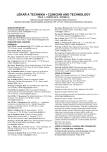-
Články
- Časopisy
- Kurzy
- Témy
- Kongresy
- Videa
- Podcasty
Raman label-free visualisation of Titanium dioxide nanoparticles uptake in BJ cell LINES
Titanium dioxide nanoparticles represent one of the most frequently applied nanomaterials. Due to its advantageous physicochemical properties affecting the final products, use of this nanomaterial in daily used products is increasing. Beside the addition into glaze or enamels, titanium dioxide nanoparticles are found in UV protective cosmetic products applied on skin. According to the studies confirming the potential carcinogenic effect of titanium dioxide nanoparticles application of such nanomaterial may cause health risk. Cellular uptake of nanoparticles and their distribution in cell environment may play an important role in nanoparticles toxicological effect. Thus, evaluation of cellular uptake of nanoparticles is the additional step for evaluation of nanoparticles toxicology. The main objective of this study was to confirm the assumption of the cellular uptake of tested TiO2 nanoparticles using human fibroblasts BJ cell lines and confocal Raman microscopy as a new, promising, label-free imaging technique for studying the distribution of exogenous substances in cells. The results of this study confirm that tested TiO2 nanoparticles are uptaken by cells and distributed in intracellular environment, where form aggregates, possibly during their transport via endocytosis.
Keywords:
titanium dioxide nanoparticles, cellular uptake, label-free, confocal Raman microscopy
Autoři: Monika Harvanová 1; Vlastimil Mašek 1; Dagmar Jirova 2; Hana Kolářová 3
Působiště autorů: Department of Pharmacology, Institute of Molecular and Translational Medicine, Faculty of Medicine and Dentistry, Palacky University in Olomouc, Czech Republic 1; Center of toxicology and Health Safety, National Institute of Public Health, Prague, Czech Republic 2; Department of Medical Biophysics, Institute of Molecular and Translational Medicine, Faculty of Medicine and Dentistry, Palacky University in Olomouc, Czech Republic 3
Vyšlo v časopise: Lékař a technika - Clinician and Technology No. 1, 2016, 46, 25-28
Kategorie: Původní práce
Souhrn
Titanium dioxide nanoparticles represent one of the most frequently applied nanomaterials. Due to its advantageous physicochemical properties affecting the final products, use of this nanomaterial in daily used products is increasing. Beside the addition into glaze or enamels, titanium dioxide nanoparticles are found in UV protective cosmetic products applied on skin. According to the studies confirming the potential carcinogenic effect of titanium dioxide nanoparticles application of such nanomaterial may cause health risk. Cellular uptake of nanoparticles and their distribution in cell environment may play an important role in nanoparticles toxicological effect. Thus, evaluation of cellular uptake of nanoparticles is the additional step for evaluation of nanoparticles toxicology. The main objective of this study was to confirm the assumption of the cellular uptake of tested TiO2 nanoparticles using human fibroblasts BJ cell lines and confocal Raman microscopy as a new, promising, label-free imaging technique for studying the distribution of exogenous substances in cells. The results of this study confirm that tested TiO2 nanoparticles are uptaken by cells and distributed in intracellular environment, where form aggregates, possibly during their transport via endocytosis.
Keywords:
titanium dioxide nanoparticles, cellular uptake, label-free, confocal Raman microscopy
Zdroje
[1] Weir, A., Westerhoff, P., Fabricius, L., Hristovski, K., von Goetz, N., 2012. Titanium dioxide nanoparticles in food and personal care products. Environ. Sci. Technol. 46, 2242-2250.
[2] Markus A. A., Parsons, J. R., Roex, E. W. M., Kenter, G. C. M., Laane, R. W. P. M., 2013. Predicting the contribution of nanoparticles (Zn, Ti, Ag) to the annual metal load in the Dutch reaches of the Rhine and Meuse. Sci. Total Environ. 456–457, 154-160.
[3] Sohaebuddin, S. K., Thevenot, P. T., Baker, D., Eaton, J. W., Tang, L., 2010. Nanomaterial cytotoxicity is composition, size and cell type dependent. Part. Fiber Toxicol. 7, p. 22.
[4] Thevenot, P., Cho, J., Wahal, D, Timmons, R. B., Tang, L., 2008. Surface chemistry influences cancer killing effect of TiO2 nanoparticles. Nanomedicine 4, 226–236.
[5] Furukawa, F., Doi, Y., Suguro, M., Morita, O., Kuwahara, H., Masunaga, A., Hatakeyama A., Mori, M., 2011. Lack of skin carcinogenity of topically applied titanium dioxide nanoparticles in the mouse, Foos Chem. Toxicol. 49, 744-749.
[6] Asare, N., Instances, C., Sandberg, W. J., Refsnes, M., Schwartze, P., Kruszwski, M. et al. 2012. Cytotoxic ang genotoxic effects of slver nanoparticles in testicular cells. Toxicology 291, 65–72.
[7] Chernenko, T., Matthäus, C., Milane, L., Quintero, L., Amiji, M., Diem, M., 2009. Label-free Raman spectral imaging of intracellular delivery and degradation of polymeric nanoparticle systems. ACS Nano 3, 3552–3559.
[8] Dorney, J., Bonnier, F., Garcia, A., Casey, A., Chambers, G., Byrne, H. J., 2012. Identifying and localizing intracellular nanoparticles using Raman soectroscopy. Analyst 137, 1111–1119.
[9] Shah, N. B., J. Dong, Bischof, J. C., 2011. Cellular uptake and nanoscale localization of gold nanoparticles in cancer using label-free confocal Raman microscopy. Mol. Pharm. 8, 176-184.
[10] IARC: Cobalt in hard metals and cobalt sulfate, galium arsenide, indium phosphide and vanadium pentoxide, 2006, Sci. Publ., 86.
Štítky
Biomedicína
Článok vyšiel v časopiseLékař a technika

2016 Číslo 1-
Všetky články tohto čísla
- Optical nerve segmentation using The Active shape method
- The viability of ovarian carcinoma cells A2780 affected by titanium dioxide nanoparticles and low ultrasound intensity
- Raman label-free visualisation of Titanium dioxide nanoparticles uptake in BJ cell LINES
- NEW METHOD FOR ESTIMATION OF FLUENCE COMPLEXITY IN IMRT FIELDS
- Measuring regularity of fine upper limb movements with a haptic platform for motor learning and rehabilitation
- Lékař a technika
- Archív čísel
- Aktuálne číslo
- Informácie o časopise
Najčítanejšie v tomto čísle- The viability of ovarian carcinoma cells A2780 affected by titanium dioxide nanoparticles and low ultrasound intensity
- Raman label-free visualisation of Titanium dioxide nanoparticles uptake in BJ cell LINES
- Optical nerve segmentation using The Active shape method
- NEW METHOD FOR ESTIMATION OF FLUENCE COMPLEXITY IN IMRT FIELDS
Prihlásenie#ADS_BOTTOM_SCRIPTS#Zabudnuté hesloZadajte e-mailovú adresu, s ktorou ste vytvárali účet. Budú Vám na ňu zasielané informácie k nastaveniu nového hesla.
- Časopisy



